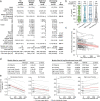Dynamics and durability of HIV-1 neutralization are determined by viral replication
- PMID: 37957379
- PMCID: PMC10667105
- DOI: 10.1038/s41591-023-02582-3
Dynamics and durability of HIV-1 neutralization are determined by viral replication
Abstract
Human immunodeficiency virus type 1 (HIV-1)-neutralizing antibodies (nAbs) that prevent infection are the main goal of HIV vaccine discovery. But as no nAb-eliciting vaccines are yet available, only data from HIV-1 neutralizers-persons with HIV-1 who naturally develop broad and potent nAbs-can inform about the dynamics and durability of nAb responses in humans, knowledge which is crucial for the design of future HIV-1 vaccine regimens. To address this, we assessed HIV-1-neutralizing immunoglobulin G (IgG) from 2,354 persons with HIV-1 on or off antiretroviral therapy (ART). Infection with non-clade B viruses, CD4+ T cell counts <200 µl-1, being off ART and a longer time off ART were independent predictors of a more potent and broad neutralization. In longitudinal analyses, we found nAb half-lives of 9.3 and 16.9 years in individuals with no- or low-level viremia, respectively, and 4.0 years in persons who newly initiated ART. Finally, in a potent HIV-1 neutralizer, we identified lower fractions of serum nAbs and of nAb-encoding memory B cells after ART initiation, suggesting that a decreasing neutralizing serum activity after antigen withdrawal is due to lower levels of nAbs. These results collectively show that HIV-1-neutralizing responses can persist for several years, even at low antigen levels, suggesting that an HIV-1 vaccine may elicit a durable nAb response.
© 2023. The Author(s).
Conflict of interest statement
A patent application encompassing aspects of this work has been filed by the University of Cologne and lists P.S., H.G. and F.K. as inventors. P.S., H.G. and F.K. received payments from the University of Cologne for licensed antibodies. J.D.B. is on the scientific advisory boards of Apriori Bio, Invivyd, Aerium Therapeutics and the Vaccine Company. J.D.B., C.E.R. and A.S.D. receive royalty payments as inventors on Fred Hutch licensed patents related to viral DMS. A.S.D. is currently an employee of Apriori Bio, although his contributions to this manuscript were performed when he was an employee of Fred Hutch before he started work at Apriori Bio. The remaining authors declare no competing interests.
Figures













References
MeSH terms
Substances
Grants and funding
LinkOut - more resources
Full Text Sources
Medical
Research Materials

